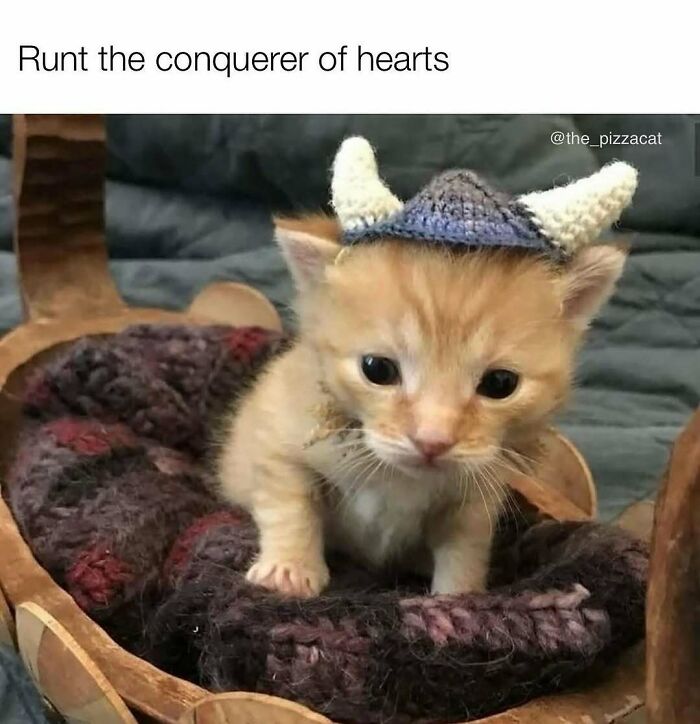Are you an ailurophile? Well, let’s find out. Can you scroll past a cat-related post or picture? Do you refrain from saying “pspsps” to a random whisker you meet on the street? Is your phone screen a photo of a kitten? Do you have a cat in your possession? If you answered no, no, yes, and yes, congratulations! You’re an ailurophile or simply put, a cat lover.
But since you clicked on this post in the first place, I assume you already knew that. So I’ll stop pussyfooting around and invite you to scroll down to find a list full of original memes masterfully crafted by the Pizzacat Instagram account.
While you’re at it, make sure to check out a conversation with the creators of Pizzacat, Mat, and Jacquelyn, who kindly agreed to tell us how the viral meme was born.


“So the pizza is photoshopped,” Mat reveals. “Please don’t put real pizza on your cat.”
“We had tabby cats named Pizza and Cheeto and I used to also make cardboard sets with them that have gone pretty viral as well. These weren’t photoshopped. Pizza loved doing these photoshoots. Cheeto liked to watch Pizza do them,” he fondly shares.
“Then, when Instagram came along, I started posting there. I even taught myself how to program iOS apps and made a Pizzacat app that got a good number of downloads and was featured by Vogue as a top 5 app for Instagram. I just never stopped, from Tumblr to Instagram, consistently posting pretty much every day,” he said, sharing the reason for the Pizzacat’s success.

“I love all animals and cats are very special,” he adds. “My cats Pizza and Cheeto were our babies. I love them, they were the sweetest cats ever. Pizza and Cheeto used to have charity fundraisers through Instagram or merchandise and raised thousands of dollars, mostly for animal rescues,” he fondly recalls.
Now, in addition to Pizzacat’s Instagram account, Mat and Jacquelyn run their website Pizzacatparty.com and their Etsy store, full of cat-themed apparel, stickers, and merchandise. Mat makes all the art, while Jacquelyn also runs their @chonksdoingthings Instagram account, which has gained a substantial following too.

The thing we were most curious to find out is why these felines fascinate them.
“Everything about them fascinates me. Particularly knowing that they are predators and yet can bond so deeply with us while remaining predators at heart and in truth,” says Quandt.
LeBaron says that she’s captivated by their versatility. “They can be barn cats, working cats in warehouses, they can be therapy cats, they can be house cats, they can be adventure cats. Society has made dogs “man’s best friend,” but cats can be anyone’s best friend.”
Meanwhile, DeVoss believes they’re an incredible example of evolution and adaptability. “They’ve carved out a niche in human society while keeping their independence intact. Some researchers argue cats aren’t fully domesticated because they can survive independently of humans. But others point out that their behavior and genetics have changed enough to qualify as domestication. I think it’s a little of both. They’re domesticated on their own terms.”
Quandt tells us that out of approximately 42 species of cats, only two raise their tails in greeting. Felines are also crepuscular, which means they’re the most active at dawn and dusk, despite some people thinking that they are the most active at night (nocturnal).
“They are also polyphasic sleepers, which just means they take lots of naps,” says Quandt. “Cats have three eyelids, the third being the nictitating membrane that is protective of their eyes but which can also be seen in sick cats,” he additionally shares.

- “Cats have a strong “place memory,” which means they remember where objects are, rather than what they look like. This helps them navigate familiar spaces and track their food sources in the wild. It’s also why they can seem puzzled if you rearrange the furniture.”
- “Hissing is a defensive body language. It is an expression of fear, stress or discomfort of a threatened cat communicating “stay away.””
- “Your house cat’s physical appearance and sensory systems are almost identical to their wild counterparts.”
- “Cats are unique amongst domestic species in that they have evolved from a solitary ancestral species.”
- “Cats may yawn as a way to end confrontation with another animal.”



“A slow blink or gentle head butt can be their way of saying, “I trust you.” Cats can be choosy about when, how, and with whom they share affection. Cats are sensitive sentient beings and respond positively to love and attention. They may appear aloof to strangers, people who shun them, or force interaction.”


In fact, cats can be trained within their limits and they need a lot of care but people usually can’t see it as felines don’t always communicate their needs and desires clearly. Similarly, cats don’t act out of anger—this is a human emotion, notes Quandt.
“People often miscategorize a behavior like urinating in one’s bed as revenge of some sort, but usually it’s something called “associative marking,” which just means your cat misses you on some level and wants to deepen their bond with you by providing a meaningful scent. Then if one punishes the cat for this, they’ve just worsened the very bond the cat is trying to improve.”

DeVoss recommends against punishing cats. “It simply doesn’t work. Punishing a cat just erodes your relationship because most cat behavior, even nuisance behaviors, are natural to them; they don’t understand why you have gone “crazy.” Bottom line: Don’t tell your cat “no!”, show it what you want it to do instead.”
Lastly, Quandt urges cat owners to think like them and get their perspective on life. “Be gentle and respectful and treat them the way they want to be treated. If your cat doesn’t like rough play, don’t play roughly with them.”






